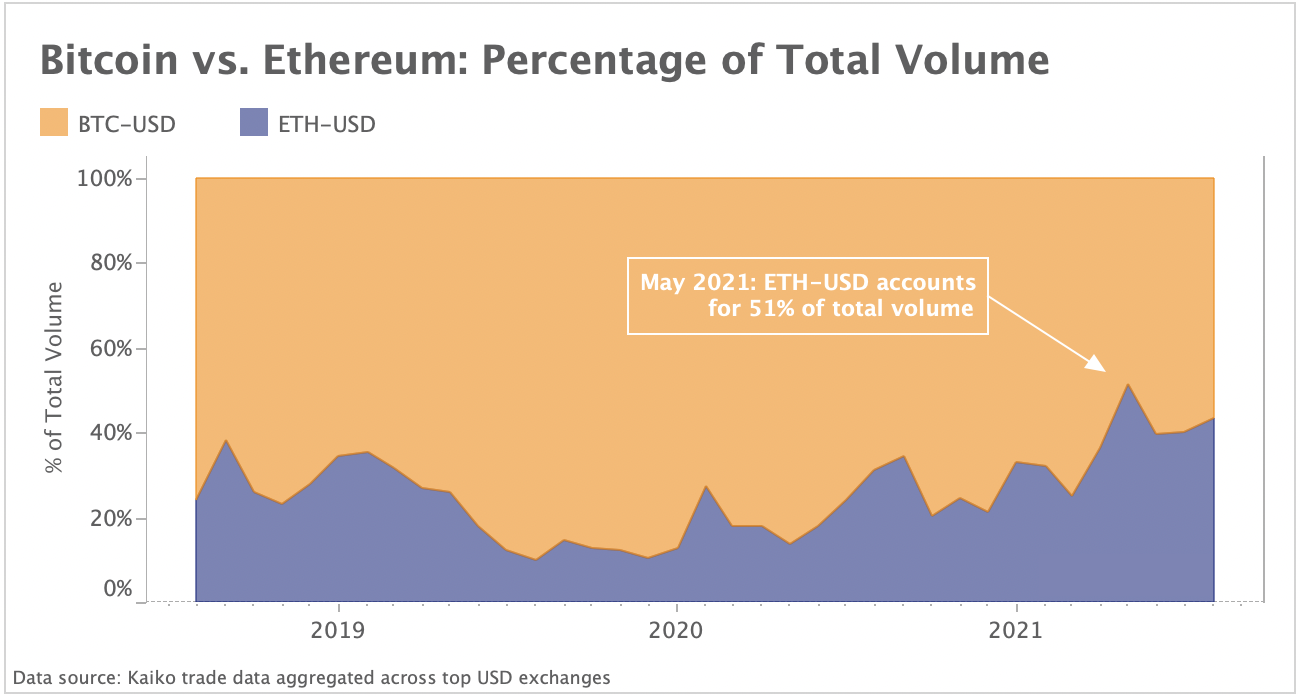A summarizing review of what has been happening at the crypto markets of the past week. A look at trending sectors, liquidity, volatility, spreads and more. The weekly report in cooperation with market data provider Kaiko.
The last 7 days in cryptocurrency markets:
- Price Movements: Bitcoin is up 8% this week, registering its largest weekly gain in months.
- Volume Dynamics: Ahead of Ethereum's big upgrade, trade volume continues to surge relative to Bitcoin.
- Order Book Liquidity: Price slippage on FTX and Binance has fallen over the past 2 months despite the regulatory crackdown on exchanges.
- Macro Trends: Microstrategy shares are up 52% YTD and currently hold a .9 positive correlation with the price of Bitcoin.
- Derivatives Markets: Trends in open interest diverged across exchanges immediately following last week's short squeeze.
Mid-summer bounce

Cryptocurrency markets finally came back to life following months of dismal returns and plummeting volumes. In the final week of July, Bitcoin and Ethereum surged +8% and +13% respectively, spurred by a massive short squeeze on perpetual futures markets. Cryptocurrency derivatives are the latest crypto sector to face the ire of global regulators. Last week, Binance and FTX, both unregulated, announced that they would be winding down derivatives trading in Europe and reduce maximum leverage from 100x to 20x. Derivatives markets frequently boast higher volumes than their underlying spot and have contributed to price volatility over the years, thus the new restrictions could significantly affect market structure.
Ethereum trade volume continues to grow ahead of big upgrade
This week, Ethereum is set to undergo the long-awaited “London” hard fork upgrade which contains five Ethereum Improvement Proposals (EIP) that will alter the code of the second largest crypto asset by market cap. Upgrades are an important part of the blockchain lifecycle that enable improvements and optimizations to the network through consensus-backed code changes. The planned changes are set to improve transaction fee volatility and wait times and introduce a fee-burning mechanism that could transform Ethereum into a deflationary asset. The upgrade is not without controversy, with some fears that it could dampen incentives for miners.
Throughout 2021, Ethereum has become an increasingly attractive crypto asset and this is best evidenced by comparing its volume relative to Bitcoin. At its peak in May, ETH-USD volumes were 51% of total volume, a record high. June and July has seen ETH-USD volumes fall 10% relative to BTC-USD, but overall market share is still near all time highs. Coinbase recently revealed that the exchange's institutional clients increased their exposure to Ethereum throughout H1 of 2021.
Slippage falls on unregulated exchanges
Despite the past month's regulatory crackdown that has threatened the world's largest exchanges, price slippage has fallen for their highly-liquid BTC-USDT markets. The four exchanges charted above contain some of the most liquid cryptocurrency markets in the world. Binance's BTC-USDT market boasts billions in volume every day while Huobi and Okex average just below $1 billion. Over the past few months, FTX has slowly claimed market share, although the exchange processes only a fraction of the volume that the others do.
Price slippage measures the cost of executing a trade and is calculated by taking the difference between the expected price and actual price once the order has been fully executed. Kaiko calculates slippage by simulating a sell order size of $50k on the bid side of an order book snapshot. We can observe that slippage has fallen over the past two months on all four exchanges, likely due to the lack of overall market volatility. Slippage fell most sharply on FTX, from 0.03% to 0.02%.
Public tech companies re-affirm interest in crypto
Crypto market sentiment has improved following another round of bullish affirmations by public tech companies. Microstrategy, up 52% YTD, announced that the company plans to continue amassing bitcoin. The company's share price is tightly correlated to Bitcoin (0.9 positive correlation) which suggests investors view the investment as a means to gain indirect exposure to crypto. Tesla also committed to holding the company's Bitcoin reserves, despite negative YTD share price returns. Square, up 16% YTD, also recently announced plans to build Bitcoin hardware wallets.
Short squeeze rattles markets
On July 25-26th, Bitcoin gained 9% over the span of just three hours following a massive short squeeze on Asian derivatives markets. More than 960 million USD in short positions were liquidated, the largest amount ever recorded. Short selling involves selling borrowed shares of an asset, betting that the price will drop. However, if the price increases instead of declining, short sellers are forced to cash-settle their contract or buy the underlying asset. This could contribute to a rapid increase in the asset's price known as a “short squeeze”.
Above, we chart the aggregated open interest across seven exchanges during the short squeeze and can observe that open interest climbed half a billion dollars in the days preceding the squeeze while volumes stayed low. This suggests traders were heavily leveraged, which led several analysts to predict the coming squeeze.








